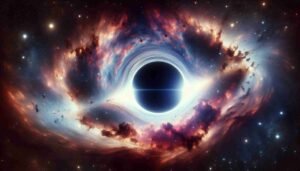
Why in news?
- In the swirling expanse of our Milky Way galaxy, a new champion has emerged. Astronomers have discovered Gaia BH3, a stellar-mass black hole boasting an impressive 33 solar masses, making it the most massive of its kind ever detected within our cosmic neighborhood.
- This behemoth, located a mere 2,000 light-years from Earth in the constellation Aquila, also holds the title of second-closest black hole to our planet.
Stellar Giants and their Dramatic Endings
- Stars, those celestial beacons dotting the night sky, are powered by nuclear fusion, a process that merges lighter elements into heavier ones, releasing tremendous energy.
- However, stars have a finite lifespan. When a particularly massive star reaches the end of its fuel reserves, it can undergo a spectacular collapse, leading to the formation of a stellar-mass black hole.
- These monstrous entities are born from the crushing force of gravity, warping spacetime to such an extent that not even light can escape their grasp.
Gaia BH3: Pushing the Boundaries
- Stellar-mass black holes typically range from a few to a few dozen times the mass of our sun.
- But Gaia BH3 defies the norm, clocking in at a staggering 33 solar masses.
- For comparison, the previous heavyweight champion, Cygnus X-1, holds a mass of only 21 solar masses.
- This discovery challenges our current understanding of how black holes form and grow.
- Traditionally, scientists believed that there was an upper limit to the mass a stellar-mass black hole could achieve before collapsing further and forming a supermassive black hole, which resides at the heart of most galaxies, including our own.
- Gaia BH3 blurs this line, prompting astronomers to re-evaluate their theories on black hole formation.
The Art of Detection: A Dance of Stars
- Unlike supermassive black holes, which can have a dramatic impact on their surroundings, stellar-mass black holes are stealthy giants.
- They are often difficult to detect directly because they don’t emit any light themselves.
- So, how did astronomers manage to find Gaia BH3? The answer lies in the intricate dance between celestial bodies.
- The European Space Agency’s Gaia mission plays a pivotal role in this cosmic detective story. Gaia is a space observatory specifically designed to map the Milky Way with unprecedented detail.
- It meticulously tracks the movements of billions of stars, measuring their positions with incredible precision. By analyzing this data, astronomers observed a curious phenomenon – a star in the Aquila constellation exhibiting a peculiar wobble in its trajectory.
- This wobble couldn’t be explained by the gravitational influence of any visible object. Enter Gaia BH3.
- The unseen influence on the star’s motion pointed towards a massive object lurking nearby.
- By meticulously analyzing the star’s wobble and calculating its orbital properties, astronomers were able to pinpoint the presence and mass of the unseen giant – Gaia BH3.
- This discovery highlights the importance of astrometric techniques, which measure the positions and motions of celestial bodies, in uncovering hidden objects in the universe.
A Gateway to Unraveling Mysteries
- The discovery of Gaia BH3 is a significant milestone in our understanding of black holes and stellar evolution.
- It opens doors to exciting new avenues of research. By studying Gaia BH3 and other similar black holes, astronomers can:
- Refine our understanding of black hole physics and how these objects interact with their environment.
- Gain insights into the upper mass limit for stellar-mass black holes.
- Improve our knowledge of how massive stars collapse and form black holes.
- Learn more about the dynamics of our galaxy and the distribution of black holes within it.
- The proximity of Gaia BH3 offers a unique opportunity for astronomers to study a massive black hole in detail.
- By observing its influence on surrounding objects and analyzing its properties.
People also ask
Q1: What is Gaia BH3?
Ans: Gaia BH3 is a stellar-mass black hole, the most massive one ever discovered in our Milky Way galaxy. It weighs a whopping 33 times the mass of our Sun!
Q2: How close is it?
Ans: At 2,000 light-years away, Gaia BH3 is the second-closest black hole to Earth, with the closest being Gaia BH1 at 1,600 light-years.
Q3: How was it found?
Ans: Astronomers couldn’t see Gaia BH3 directly, but they noticed a star in the constellation Aquila wobbling strangely. The European Space Agency’s Gaia mission, which precisely tracks stellar movements, helped identify this wobble. The influence on the star’s motion pointed towards a massive object nearby – Gaia BH3.
I don’t think the title of your article matches the content lol. Just kidding, mainly because I had some doubts after reading the article.
Your article helped me a lot, is there any more related content? Thanks!
Your article helped me a lot, is there any more related content? Thanks!
Your article helped me a lot, is there any more related content? Thanks!
Your point of view caught my eye and was very interesting. Thanks. I have a question for you.